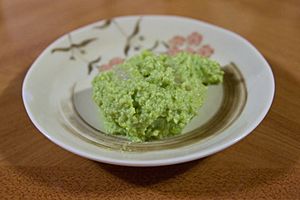Zunda-mochi facts for kids

Zunda-mochi
|
|
| Type | Confectionery |
|---|---|
| Place of origin | Japan |
| Region or state | East Asia |
| Invented | 13th century? |
| Main ingredients | soybeans, glutinous rice, sugar, salt |
| Variations | numerous |
| Similar dishes | zunda-daifuku, kurumi-mochi |
Zunda-mochi (ずんだ餅) is a yummy Japanese sweet treat. It's very popular in northeastern Japan. People sometimes call it "green soybean rice cake."
This sweet usually has a soft, round cake made from sticky glutinous rice. On top, there's a sweet paste made from mashed green soybeans. Sometimes, the green soybean paste completely covers the white rice cake. Only young, green soybeans, called edamame, are used to make the paste. There's also a similar sweet called "kurumi-mochi," which uses walnuts instead of soybeans.
Contents
How Did Zunda-mochi Get Its Name?
There are a few cool stories about where the name zunda-mochi came from.
The "Bean-Mashing" Story
One idea is that the word zunda comes from zuda (豆打). This word means "bean-mashing." It makes sense because you mash soybeans to make the paste!
The Warlord's Sword Story
Another story says zunda came from the jindachi sword of a famous warlord named Date Masamune. He was a powerful leader during Japan's Sengoku period (a time of many wars). Legend says he mashed beans with his sword!
The Farmer Jinta Story
A third story tells of a farmer named Jinta. He supposedly came up with the idea for this dish. Warlord Date Masamune liked it so much that he named it "jinta mochi." Over time, the name changed to zunda-mochi.
Also, in some parts of northern Japan, people say "mozu" instead of "mochi." So, you might hear different names for this sweet treat!
A Sweet History of Zunda-mochi
Zunda-mochi has been around for a very long time. It dates back at least to Japan's Sengoku period, which was a time of many battles and changes.
Early Mentions and Favorites
This sweet is even mentioned in a diary from Prince Gosuko-in, who lived a long time ago (1372-1456). It's said that Date Masamune, the famous warlord, loved zunda-mochi. That's why zunda-mochi is often seen as a special food from Sendai city.
From Farms to Festivals
Long ago, rice farmers would make zunda-mochi after they harvested their summer soybeans and rice. It was often used as a special offering during traditional Japanese festivals like obon and higan. Later, it became a traditional sweet for important events like weddings and funerals in some parts of northern Japan.
Zunda-mochi Today: New Ways to Enjoy It
Today, you can find zunda-mochi in many different forms. It's not just a simple rice cake anymore!
Popular Treats and Snacks
You can even buy zunda-mochi gift sets from Japan Post, which is Japan's biggest mail service. This shows how popular it is!
- Zunda-daifuku is another popular sweet. It's like an "inside-out" zunda-mochi, with the sticky rice on the outside and the sweet bean paste inside.
- You can also find zunda cream dorayaki. These are like two small pancakes with a creamy, sweet soybean filling in the middle.
- Zunda-mochi ice cream is available in some parts of Sendai city. In 2019, even Häagen-Dazs made a special limited edition of this ice cream!
- Since 2009, Nestlé Japan has sold "Zunda-mochi" flavor Kit-Kat bars in northern Japan.
- You can also enjoy zunda-mochi shaved ice and milkshakes. You can find these not only in Japan but even in Hawaii!
Zunda-mochi foods keep changing and growing. They often mix ideas from Western and Japanese cooking, creating new and exciting flavors!

